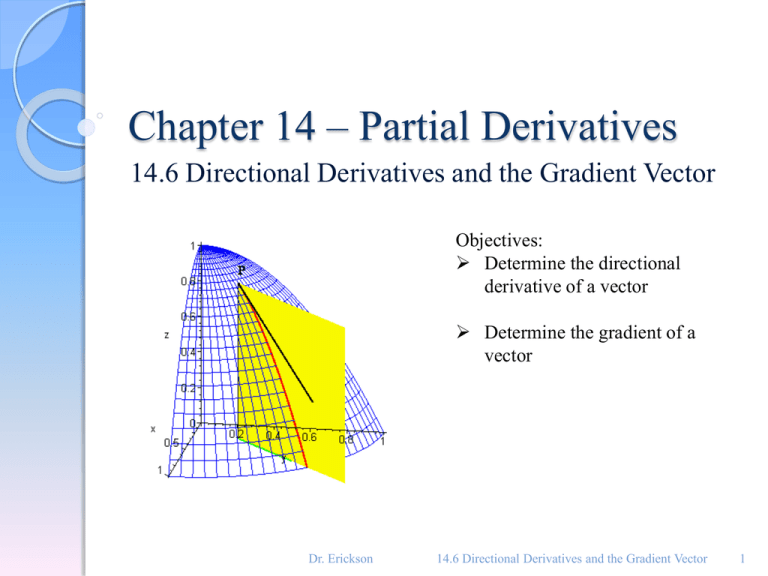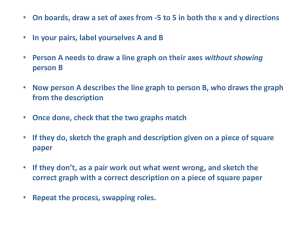14.6 Directional Derivativess & Gradient Vectors
advertisement

Chapter 14 – Partial Derivatives 14.6 Directional Derivatives and the Gradient Vector Objectives: Determine the directional derivative of a vector Determine the gradient of a vector Dr. Erickson 14.6 Directional Derivatives and the Gradient Vector 1 Definition – Directional Derivative Dr. Erickson 14.6 Directional Derivatives and the Gradient Vector 2 Visualization Directional Derivatives Dr. Erickson 14.6 Directional Derivatives and the Gradient Vector 3 Theorem Dr. Erickson 14.6 Directional Derivatives and the Gradient Vector 4 Note If the unit vector u makes an angle with the positive x-axis, then we can write u = <cos , sin > and the formula in theorem 3 becomes Du f x, y f x x, y cos f y x, y sin Dr. Erickson 14.6 Directional Derivatives and the Gradient Vector 5 Example 1- pg. 920 # 4 Find the directional derivative of f at the given point in the direction indicated by the angle θ. f ( x, y ) x y y , (2,1), 2 3 4 Dr. Erickson 14.6 Directional Derivatives and the Gradient Vector 4 6 Example 2 Find the directional derivative of f at the given point in the direction indicated by the angle θ. f ( x, y ) x sin( xy ), (2, 0), Dr. Erickson 14.6 Directional Derivatives and the Gradient Vector 3 7 Definition - Gradient The gradient of f, ∇f, is read “del f”. Dr. Erickson 14.6 Directional Derivatives and the Gradient Vector 8 Properties of the Gradient The gradient of a multi-variable function has a component for each direction. Be careful not to confuse the coordinates and the gradient. The coordinates are the current location, measured on the x-y-z axis. The gradient is a direction to move from our current location, such as move up, down, left or right. The gradient at any location points in the direction of greatest increase of a function. Dr. Erickson 14.6 Directional Derivatives and the Gradient Vector 9 Directional Derivative and Gradient We can now rewrite the directional derivative as which expresses the directional derivative in the direction of u as the scalar projection of the gradient vector onto u. Dr. Erickson 14.6 Directional Derivatives and the Gradient Vector 10 Directional Derivative and Gradient What is the difference between the two? ◦ The gradient is a vector quantity that points in the direction of greatest increase and has a magnitude equal to the rate of change in that direction. ◦ The directional derivative is a scalar quantity giving the rate of change in a specified direction. It is equal to the dot product of the gradient with a unit vector in the desired direction. Dr. Erickson 14.6 Directional Derivatives and the Gradient Vector 11 Directional Derivative and Gradient What is the difference between the two? ◦ The gradient uses all of the partials. ◦ A directional derivative uses only one partial. ◦ The gradient is a vector orthogonal to a level curve (surface, etc.). ◦ A directional derivative measures how function values change with respect to movement in a particular direction in the domain...and it is not a vector Dr. Erickson 14.6 Directional Derivatives and the Gradient Vector 12 Example 3 – pg. 943 # 8 2 y 1 f ( x, y ) , P(1,2), u 2i 5 j x 3 Find the gradient of f. b) Evaluate the gradient at the point P. c) Find the rate of change of f at P in the direction of vector u. a) Dr. Erickson 14.6 Directional Derivatives and the Gradient Vector 13 Definition – Directional Derivative If we use vector notation, then the definition is more compact. Dr. Erickson 14.6 Directional Derivatives and the Gradient Vector 14 Definition - Gradient The gradient of f is and can be rewritten as Dr. Erickson 14.6 Directional Derivatives and the Gradient Vector 15 Example 4 2 3 6 f ( x, y, z ) x yz , P(1,3,1), u , , 7 7 7 Find the gradient of f. b) Evaluate the gradient at the point P. c) Find the rate of change of f at P in the direction of vector u. a) Dr. Erickson 14.6 Directional Derivatives and the Gradient Vector 16 Maximizing the Directional Derivative Visualization ◦ Maximizing the Directional Derivative Dr. Erickson 14.6 Directional Derivatives and the Gradient Vector 17 Example 5 Find the maximum rate of change of f at the given point and the direction in which it occurs. p q f ( p, q) qe pe , (0,0) Dr. Erickson 14.6 Directional Derivatives and the Gradient Vector 18 Example 6 Find the maximum rate of change of f at the given point and the direction in which it occurs. f ( x, y, z) tan(x 2 y 3z), (5,1,1) Dr. Erickson 14.6 Directional Derivatives and the Gradient Vector 19 The equation ∇F(x0,y0,z0)∙r’(t0) says that the gradient vector at P, ∇F(x0,y0,z0),is perpendicular to the tangent vector r’(t0) to any curve C on S that passes through P. Dr. Erickson 14.6 Directional Derivatives and the Gradient Vector 20 Definition If ∇F(x0,y0,z0)≠0, it is thus natural to define the tangent plane to the level surface F(x, y, z) = k at P(x0, y0, z0) as the plane that passes through P and has normal vector ∇F(x0,y0,z0). This equation of a tangent plane can be written as Dr. Erickson 14.6 Directional Derivatives and the Gradient Vector 21 Normal Line The normal line to S at P is the line: ◦ Passing through P ◦ Perpendicular to the tangent plane The direction of the normal line is given by the gradient vector ∇F(x0,y0,z0) and its symmetric equations are x x0 y y0 z z0 Fx ( x0 , y0 , z0 ) Fy ( x0 , y0 , z0 ) Fz ( x0 , y0 , z0 ) Dr. Erickson 14.6 Directional Derivatives and the Gradient Vector 22 Example 7 Find the equations of (a) the tangent plane and (b) the normal line to the given surface at the specified point. x z 4 arctan(yz), (1 ,1,1) Dr. Erickson 14.6 Directional Derivatives and the Gradient Vector 23 Group work 1. Pg. 944 # 28 Find the directions in which the directional derivative of the function below at the point (0,2) has the value of 1. xy f ( x, y) ye Dr. Erickson 14.6 Directional Derivatives and the Gradient Vector 24 Group work 2. Pg. 944 # 32 The temperature at a point (x, y, z) is given by T ( x, y, z) 200e x 2 3 y 2 9 z 2 Where T is measured in oC and x, y, z in meters. a) Find the rate of change of temperature at the point P(2,-1,2) in the direction towards the point (3, -3, 3). b) In which direction does the temperature increase the fastest at P? c) Find the maximum rate of increase at P. Dr. Erickson 14.6 Directional Derivatives and the Gradient Vector 25 Group work 3. Pg. 944 # 34 Suppose you are climbing a hill whose shape is given by the equation z 1000 0.005x2 0.01y 2, where x, y, and z are measured in meters, and you are standing at the point with coordinates (60, 40, 996). The positive x-axis points east and the positive y-axis points another. a) b) c) If you walk due south, will you start to ascend or descend? At what rate? If you walk northwest, will you start to ascend or descend? At what rate? In which direction is the slope the largest? What is the rate of ascent in that direction? At what angle above the horizontal does the path in that direction begin? Dr. Erickson 14.6 Directional Derivatives and the Gradient Vector 26 Group work 4. Pg. 945 # 50 2 2 If g ( x, y ) x y 4 x find the gradient vector g (1,2) and use it to find the tangent line to the level curve g(x, y)=1 at the point (1,2). Sketch the level curve, the tangent line, and the gradient vector. Dr. Erickson 14.6 Directional Derivatives and the Gradient Vector 27 More Examples The video examples below are from section 14.6 in your textbook. Please watch them on your own time for extra instruction. Each video is about 2 minutes in length. ◦ Example 4 ◦ Example 5 ◦ Example 8 Dr. Erickson 14.6 Directional Derivatives and the Gradient Vector 28 Demonstrations Feel free to explore these demonstrations below. ◦ Directional Derivatives in 3D ◦ Maximizing Directional Derivatives Dr. Erickson 14.6 Directional Derivatives and the Gradient Vector 29







